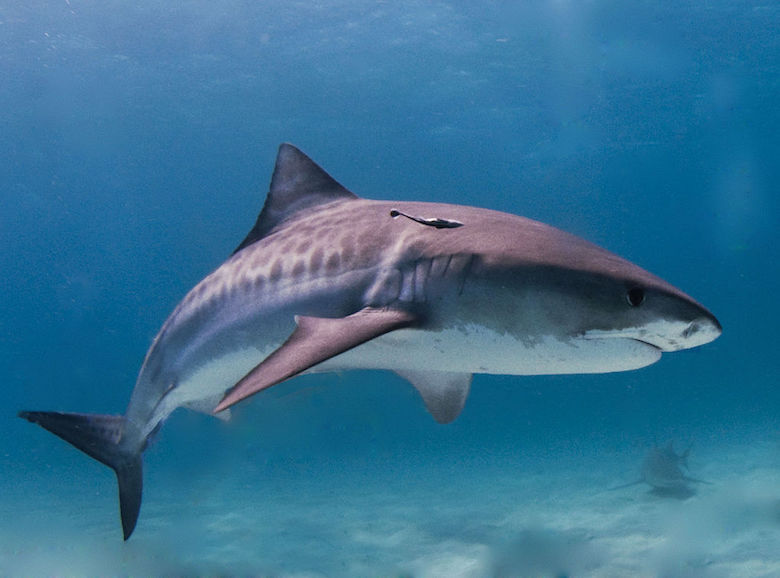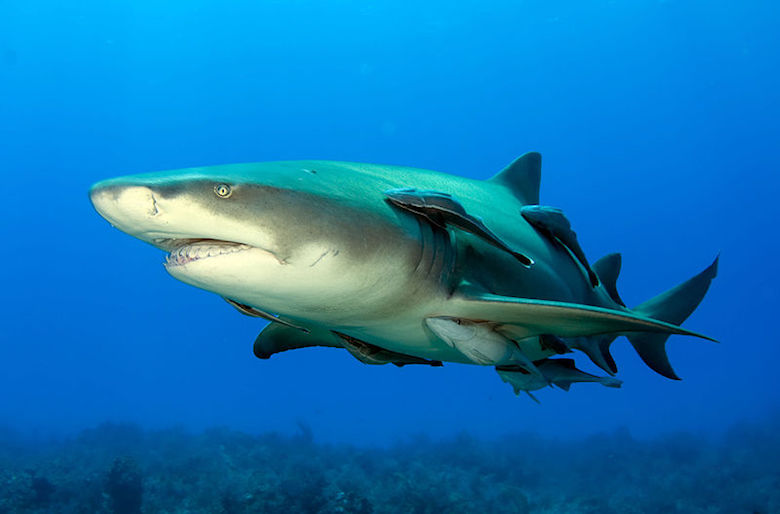- This year a record-breaking number of shark attacks occured in places such as Hawaii, North Carolina, and New South Wales, Australia, raising an outcry from some communities for their governments to kill off sharks.
- Recent summits convened to investigate the latest shark-deterring technologies have concluded that culling is not the answer.
- Among the new shark-deterrents under study are methods that exploit the animals’ electric, magnetic, visual, olfactory, and auditory sensory systems.
The sea is not our natural environment, but we’ve learned to enjoy it, seeking pleasure from the waves and cooling waters. Spending time in this environment, humans inevitably come into contact with its apex predators, which we are not expertly equipped to sense and avoid. This year has brought a record-breaking number of shark attacks in places such as Hawaii, North Carolina, and New South Wales, Australia, raising an outcry from some communities for their governments to kill off sharks. Authorities in Queensland killed nearly 700 sharks last year, sweeping up dolphins, dugongs, and sea turtles in the process, according to Australia’s ABC news service, and the state of Western Australia promoted, then rescinded, a controversial shark culling policy. Although shark attacks are remarkably rare — the odds of the average American being killed by a shark is estimated at just 1 in 3.7 million, for example — the media attention that surrounds each incident incites a frenzied fear.
Instead of bending to impassioned pressure, local governments including those in New South Wales and South Africa have recently held summits to investigate the latest shark-deterring technologies, and concluded that culling is not the answer. Scientists, animal advocates, and shark-attack victims themselves have also spoken out condemning the lethal approach.
“[I]t pains me to hear people that love the ocean, especially surfers, advocate the culling of sharks because they represent a danger to humans,” Nathan Hart, a shark and neurobiology researcher at Macquarie University in Australia, told Mongabay. “As a nation, we need to reassess our approach to water safety both in terms of the use of safety equipment during activities such as surfing and also accepting a residual level of risk if we choose to engage in these activities.”

Despite the localized calls for killing, a new study, conducted among residents of Western Australia, found that although people admit they are afraid of sharks, 80 percent of them don’t actually support culling. Removing sharks could harm species already threatened with extinction, disrupt ecosystems, and even, according to one study, accelerate climate change by freeing prey to munch seabed vegetation and disturb sediment, releasing carbon into the atmosphere.
Removing people from the oceans is also financially and socially unviable. Increased temperatures coupled with burgeoning human populations have brought more people into the water, contributing to the high number of shark attacks this year.
Besides controversial, lethal baited hooks, current attack-prevention methods include helicopter patrols and shark nets that form perimeters around swimming areas. The patrols are costly, however, and the nets entangle and kill not just sharks but other marine life. The new technologies discussed at the recent summits are designed to circumvent these problems and allow humans to enter the oceans more safely.
Exploiting sharks’ senses
Sharks possess a number of advanced sensory systems that many of the new technologies have sought to understand and exploit. To start with, they have a complex electroreceptory system that allows them to detect electrical fields, like those generated by moving prey. Thousands of pores on their snouts and heads contain small jelly-like bulbs called ampullae of Lorenzini, which carry electrical signals to adjacent nerves.
Innovators have exploited this electrical sense since the 1960s, beginning with an electrical barrier that produced inconclusive results. Twenty years ago a South African company called POD Holdings Ltd. invented the first wearable deterrent. The SharkPOD, as it was called, emitted electrical waves intended to cause uncomfortable muscle spasms in nearby sharks. Initial testing seemed positive, but the SharkPOD was large, heavy, and prohibitively expensive. Australian company Shark Shield Pty. Ltd. refined the device, and launched the more practical Shark Shield in 2002. The current product range consists of three wearable or mountable devices that trail two-meter-long antennas housing electrodes to zap sharks in the vicinity.

Preliminary data shows the Shark Shield can repel tiger (Galeocerdo cuvier) and great white sharks (Carcharodon carcharias). Independent testing of a model worn on the ankle was inconclusive, but in new government-funded research being published in December, the SharkShield reportedly outperformed another commercially available electronic anklet device and deterred sharks in 90 percent of trials.
Sharks are thought to navigate their oceans by detecting the Earth’s magnetic fields, and several shark deterrents have attempted to exploit this magnetic sense. Charged particles that pass through magnetic fields create an electrical field around the shark, which the ampullae of Lorenzini detect.
Studies have shown that magnets can prevent sharks from passing through openings, although sharks habituated somewhat to the magnets. Researchers have therefore suggested further developments, including rotating magnets through the water to create peaks and troughs in the magnetic field that could eliminate habituation.

Researchers from Stellenbosch University in South Africa, University of Massachusetts Dartmouth, and a South African company called Shark Diving Unlimited used magnets to create the Sharksafe Barrier, which they bill an eco-friendly alternative to shark nets. The barrier works rather like a floating fence, anchored to the sea floor and extending all the way to the surface. It consists of a series of independently mobile, flexible columns with magnets inside that deter sharks and rays, but not other fish. Perhaps due to the constant movement of magnets with the water current, an initial peer-reviewed assessment did not find habituation among great white sharks. Neither they nor bull sharks (Carcharhinus leucas), assessed in a separate study, passed through the barriers once. However, the Sharksafe Barriers used in these trials weren’t wide enough to exclude sharks from specific areas, and sharks were easily able to swim around them, so more testing is underway.
Despite the addition of magnets, the Sharksafe Barrier’s original shark-deterring feature was actually its visual appearance. The columns resemble kelp seaweed, through which great white sharks are reluctant to pass, even when hunting a seal. The researchers have seen an increased efficiency of the barriers when they use multiple rows to create something resembling a kelp “forest.”
Exploiting sharks’ visual sense is an active area of research when it comes to wearable deterrents. Recently Phil Richardson, a researcher and project manager with the South African company Human Wildlife Solutions, has been testing the effectiveness of orca-patterned wetsuits and surfboards.
“My first thought was that sharks are scared of two things — bigger sharks and orcas,” which have been documented preying on sharks, Richardson told Mongabay.
“I hit on the [orca] belly pattern, which is not only distinctive, but has, I believe, been ‘copied’ or mimicked by the Heaviside’s dolphin,” he said. “If the mimicry is working for a dolphin it should work for humans as well.”

Richardson said he based his idea on “sign stimuli,” the scientific term for patterns that send such a strong message that they can elicit a behavior in their intended recipient even if the rest of the pattern-bearing animal is missing. He doesn’t believe that habituation, resulting in sharks either attacking baby orcas or comprehending that orca-patterned people aren’t really orcas, will be a problem, since sharks and people don’t actually collide all that often.
Although Richardson is still refining his orca-patterned wetsuits and surfboards, his initial field-testing showed that sharks aborted their attacks more often on decoys with an orca-belly pattern than on plain black or black-and-white checkered decoys.
In 2011, researchers discovered that shark eyes possess only one type of cone cell for color vision, suggesting they are colorblind. Their visual sensitivity therefore lies in other realms, such as their perception of brightness. It is this that the Australian company Shark Attack Mitigation Systems has tapped into to develop “cryptic” wetsuits that in theory allow a swimmer to blend in to the surrounding ocean. Using special software, company researchers modeled underwater light fields to determine sharks’ ability to differentiate adjacent objects, perceive various wavelengths of light, and gather light.
This allowed them to predict reflectance spectra that should appear less recognizable to a shark compared with the spectra of traditional wetsuits, and to develop different models for swimmers at the surface and divers at various depths. The company licenses its technology to wetsuit companies who incorporate it into their designs. The resulting suits resemble blue-hued army camouflage, but buyers wear them at their own risk as field-testing is still underway.
Inventors are also exploiting sharks’ incredible sense of smell, which contributes to their remarkable ability to detect prey even from great distances. Past research efforts harnessing the power of chemicals have focused on irritating sharks’ nostrils, but newer investigations are working on identifying semiochemicals — biologically important chemicals that tell sharks something about their environment. Reports from fishermen suggest that sharks avoid areas containing dead sharks, and led researchers to hypothesize that the flesh releases semiochemicals that they can detect and avoid.
After years of investigation, researchers extracted so-called “necromone” compounds from putrefied shark flesh and housed them in aerosol cans, which are now commercially available. A 2014 study showed that Caribbean reef sharks (Carcharhinus perezii) and blacknose sharks (Carcharhinus acronotus) stopped eating bait within one minute of researchers releasing necromones nearby. The researchers write that sharks of both species displayed a “spectacular alarm response” and left the test areas. Furthermore, the sharks showed no habituation to the necromone after repeated tests in the same areas, suggesting it could work for personal defense by divers and swimmers.
In a review of shark deterrent technologies released earlier this year, Hart and colleague Shaun Collin, a sensory biologist at the University of Western Australia’s Oceans Institute, note that there may be other semiochemicals meaningful to sharks that people could figure out how to exploit. Perhaps people could deploy the compounds sharks detect in their prey or the pheromones that attract sharks to one another to draw them away from swimming areas.

Exploiting sharks’ hearing seems to be the least fruitful area of technological development. The SharkStopper, which boasts that it is the “first and only acoustic shark repellent,” is another device worn on the body. Back in the 1970s, scientists showed that captive lemon (Negaprion brevirostris) and silky (Carcharhinus falciformis) sharks swam away from the recorded scream of a killer whale. Research indicating the sound frequencies that sharks are most sensitive to let inventors refine the scream to develop the SharkStopper. The product’s website claims some successful field trials, but the SharkStopper hasn’t been assessed independently. In their review, Hart and Collin point out that in the 1970s study, sharks habituated to the recorded noises of killer whales and they suggest that any deterrent noises should only be used for short durations.
Worldwide research effort
Hart is part of the worldwide research effort to develop new technologies to safeguard swimmers and was involved in developing the cryptic wetsuits, among other products. “We are trying to find ways to manipulate [sharks’] natural behaviors, rather than just relying on delivering an unpleasant stimulus when they get too close,” he told Mongabay. “In fact, the combination of these approaches is likely to be the most effective shark attack mitigation strategy.”
He added that scarce funding for research in to sharks’ basic biology “is a major limitation in the development of new technologies.”

This year, New South Wales, Australia, has so far recorded a devastating 14 unprovoked shark attacks, up from just three in 2014. Only one person died, but the year isn’t up and peak shark-encounter season is still underway. Last month, the New South Wales government announced a $16 million AUD ($11.5 million USD) investment in testing shark deterrents.
Six beaches in the state will trial new eco-friendly barrier nets made from recycled tires. Camera-carrying drones will work in tandem with pricier helicopter surveillance to monitor the seascape. The government will also deploy Clever Buoys at five beaches — devices that use sonar to detect and distinguish shark-shaped objects moving through the water. And twenty 4G listening stations floating offshore will pick up signals emitted from acoustic tags attached to sharks. Both the Clever Buoys and the listening stations will send real-time updates via satellite when they detect sharks, alerting beach lifeguards. The goal is for data to be publicly available via a government-funded SharkSmart smartphone app that lets users make informed decisions about where and when to enter the ocean.
The new technologies based on exploiting shark senses haven’t made it onto the list, likely because many are in early stages of development. But the New South Wales government’s ambitious testing program and sizeable investment indicate that rigorous science will take precedent over shark culling in the future, setting an example for shark-attack afflicted areas around the world.
Citations
- Gibbs, L., & Warren, A. (2015). Transforming shark hazard policy: Learning from ocean-users and shark encounter in Western Australia. Marine Policy 58: 116-124.
- Huveneers, C., Rogers, P.J., Semmens, J.M., Beckmann, C., Kock, A.A., Page, B., & Goldsworthy, S.D. (2012). Effects of the Shark Shield TM electric deterrent on the behaviour of white sharks (Carcharodon carcharias). Final report to SafeWork South Australia. Version 2. South Australian Research and Development Institute (Aquatic Sciences), Adelaide. SARDI Publication No. F2012/000123-1. SARDI Research Report Series No. 632. 61pp.
- O’Connell, C.P., Abel, D.C., Gruber, S.H., Stroud, E.M., & Rice, P.H. (2011). Response of juvenile lemon sharks, Negaprion brevirostris, to a magnetic barrier simulating a beach net. Ocean & Coastal Management 54(3): 225-230.
- O’Connell, C.P., Andreotti, S., Rutzen, M., Meÿer, M., Matthee, C.A., & He, P. (2014). Effects of the Sharksafe barrier on white shark (Carcharodon carcharias) behavior and its implications for future conservation technologies. Journal of Experimental Marine Biology and Ecology 460: 37-46.
- O’Connell, C.P., Hyun, S.Y., Rillahan, C.B., & He, P. (2014). Bull shark (Carcharhinus leucas) exclusion properties of the sharksafe barrier and behavioral validation using the ARIS technology. Global Ecology and Conservation 2: 300-314.
- Hart, N.S., Theiss, S.M., Harahush, B.K., & Collin, S.P. (2011). Microspectrophotometric evidence for cone monochromacy in sharks. Naturwissenschaften 98(3): 193-201.
- Stroud, E.M., O’Connell, C.P., Rice, P.H., Snow, N.H., Barnes, B.B., Elshaer, M.R., & Hanson, J.E. (2014). Chemical shark repellent: Myth or fact? The effect of a shark necromone on shark feeding behavior. Ocean & Coastal Management 97: 50-57.
- Hart, N.S., & Collin, S.P. (2015). Sharks senses and shark repellents. Integrative zoology 10(1): 38-64.
- Myrberg Jr, A.A., Gordon, C.R., & Klimley, A.P. (1978). Rapid withdrawal from a sound source by open‐ocean sharks. The Journal of the Acoustical Society of America 64(5): 1289-1297.
- West, J.G. (2011). Changing patterns of shark attacks in Australian waters. Marine and Freshwater Research 62(6): 744-754.
